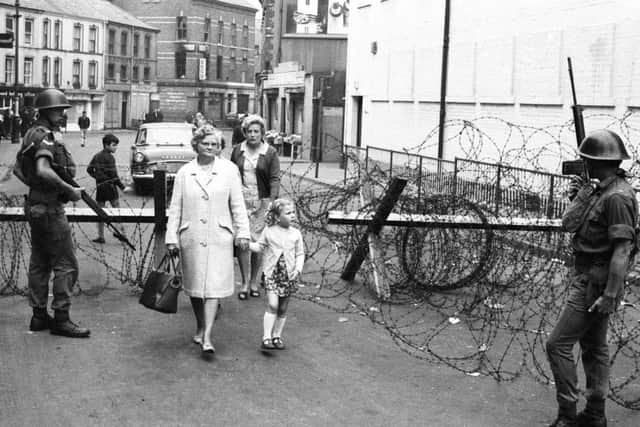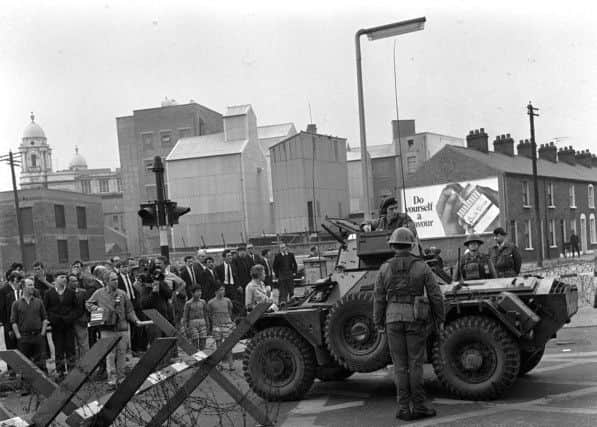50 years on, legacy of Ulster troubles are remembered in silence


Exactly half a century after the army had deployed troops to the streets of Northern Ireland, their presence was remembered in silence, among 30,000 trees.
The Royal British Legion had organised the commemorative event at the National Arboretum in Staffordshire for Operation Banner, the Army’s official name for the longest continuous military campaign in its history.
Advertisement
Hide AdAdvertisement
Hide AdBen Wallace, the Defence Secretary, was among the 2,000 veterans remembering what the civilian population came to know euphemistically as The Troubles. He did not make a speech.


On Saturday in Lisburn, near Belfast, some 10,000 veterans and their families are expected at another memorial event.
But if yesterday’s ceremony, 12 years after Banner officially ended, was kept deliberately low-key, emotions remained raw, on both sides of the sectarian divide.
Martyn McCready, whose father was shot dead by republicans on his mother’s birthday in north Belfast in 1976, remembered the arrival of British soldiers changing the atmosphere “for the better”, and that he felt “reassured” by their presence.
Advertisement
Hide AdAdvertisement
Hide AdBut Briege Voyle’s memory was of the time the Army “turned” and shot dead her mother dead. A year earlier, she had served them tea and sandwiches at her family’s home.


“One minute they were our friends, the next minute they weren’t. They just saw everyone as the enemy. They thought every Catholic was an IRA person,” Ms Voyle said.
At its peak, the Army had 28,000 personnel in Ulster, attempting to re-occupy nationalist areas of Belfast and Londonderry.
They had arrived, in August 1969, after sustained violence wore out the local police, and Northern Ireland’s government at Stormont urged Westminster to step in, literally.
Advertisement
Hide AdAdvertisement
Hide AdSoldiers were deployed on the streets, at checkpoints and in patrol vehicles and made a ready target for an emerging Provisional IRA.
In South Armagh and elsewhere, it became so dangerous that travel had to be done by helicopter.
A republican pub bombing in Co Londonderry encapsulated the terror at its height, recalled former Colonel Bob Stewart, now a Conservative MP but at the time, in December 1982, commanding officer at the scene.
“I held a girl, who I think was a Catholic, as she died. She had lost both legs and an arm – she was 18,” he said. She was among 17 – 11 soldiers and six civilians – to die at the Droppin’ Well pub in Ballykelly, at the hands of the The Irish National Liberation Army. Some, said Mr Stewart, “were just like joints of meat”.
Advertisement
Hide AdAdvertisement
Hide AdIt was probably the worst experience of his life,” he added, but it was one tragedy among hundreds, in a province where day-to-day life was like the rest of the UK – except when it turned nasty. It could do that very quickly, Mr Stewart said.
Tom Wharton, a 19-year-old Lance Corporal in the Green Howards, based at Richmond Barracks in Yorkshire, did not know what to expect when, in 1970, he embarked on the first of 10 tours of Ulster.
“It was as if we had landed in a different country,” he said. “It wasn’t the conventional warfare we had trained for. Law and order had broken down and we were the new policemen.”
His second tour saw six of his unit killed. Caught in a boobytrap in the Ardoyne district of Belfast in 1971, he lost his left calf.
Advertisement
Hide AdAdvertisement
Hide AdMr Wharton, the author of a book on the Green Howards in the province, said: “We were just kids on the streets there.”
• Northern Ireland remains a deeply divided community, with sectarianism rife and an undercurrent of violence fuelled by drugs, a Yorkshire academic said.
“There are small groups of very determined people on both sides who still are committed to violence, and there are criminal elements that make common cause with them,” said Prof Donna Pankhurst, in the Peace Studies department at Bradford University.
Regular occurrences of “quite extreme violence” in Belfast and other locations across the province went largely unreported in England, she added.
Advertisement
Hide AdAdvertisement
Hide Ad“In the poorest parts of Belfast, there are no-go areas for the police which are completely controlled by self-styled paramilitaries who identify themselves with one or other group, working with criminals to control the drugs trade, who still exert punishment – beatings and shootings – often on children
“They’re not supported by the mainstream political parties. But they still try to manipulate poorer people into supporting their cause, along the old lines.”
Few in the province wanted to return to the violence of the past, Prof Pankhurst said, but she added: “Segregation is extremely strong. And in the last few years, in housing for instance, it has actually got worse.
“There are very few mixed Catholic and Protestant schools. You can still tell from somebody’s name, from what road they live on, which community they identify with.”